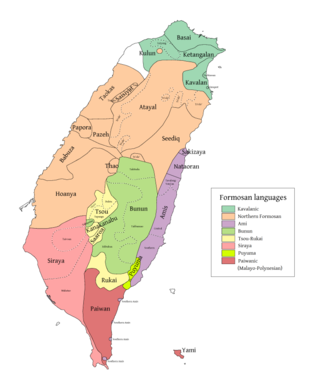
Amis language
| Amis | |
|---|---|
| 'Amis or Pangcah | |
| Pronunciation | [paŋt͡saʜ] |
| Native to | Taiwan |
| Ethnicity | 200,000 Amis (2014)[1] |
Native speakers | 110,000 (2015)[2] |
Austronesian
| |
| Latin script | |
| Language codes | |
| ISO 639-3 | ami |
| Glottolog | amis1246 |
| IETF | ami[3] |
 Distribution of Amis language (purple) | |
 Amis is classified as Vulnerable by the UNESCO Atlas of the World's Languages in Danger | |
Amis (Sowal no 'Amis or Pangcah) is a Formosan language of the Amis (or Ami), an indigenous people living along the east coast of Taiwan. Currently the largest of the Formosan languages, it is spoken from Hualien in the north to Taitung in the south, with another population in the Hengchun Peninsula near the southern end of the island, though the northern varieties are considered to be separate languages.

Government services in counties where many Amis people live in Taiwan, such as the Hualien and Taitung railway stations, broadcast in Amis alongside Mandarin. However, few Amis under the age of 20 in 1995 spoke the language. It is not known how many of the 200,000 ethnic Amis speak the language, but overall a third of the aboriginal Taiwanese population does.

Dialects
Amis is a dialect cluster. There are five dialects: Southern Amis, Tavalong-Vataan, Central Amis, Chengkung-Kwangshan, and Northern Amis (Nanshi Amis, which includes Nataoran).

Sakizaya is a moribund language spoken among the northernmost ethnic Amis but is mutually unintelligible with the Northern Amis dialect.

Phonology
The following discussion covers the central dialect of Amis.[4]

Consonants
| Labial | Dental | Alveolar | Palatal | Velar | Epiglottal | Glottal | |
|---|---|---|---|---|---|---|---|
| Nasals | m | n̪ ⟨n⟩ | ŋ ⟨ng⟩ | ||||
| Plosives and affricate |
p | t̪ ⟨t⟩ | t͡s ⟨c⟩ | k | ʡ ~ ʢ ⟨ʼ⟩ | ʔ ⟨^⟩ | |
| Fricatives | v ⟨f⟩ | ð ~ ɮ̪ ⟨d⟩ | s ⟨s⟩ | (ɣ) ⟨g⟩ | ʜ ⟨h⟩ | ||
| Trill | r ⟨r⟩ | ||||||
| Lateral flap | ɺ̠ ⟨l⟩ | ||||||
| Approximants | w ⟨w⟩ | j ⟨y⟩ |
The voiced velar fricative /ɣ/ is in parentheses because it only occurs in some loanwords, such as rigi /riˈɣiʔ/ 'ridge between sections of a rice field'.

The epiglottal consonants have proven difficult to describe, with some sources describing them as pharyngeal or even uvular as opposed to epiglottal. It's unclear if [h] is a separate phoneme from [ʜ] or if it's just an allophone of it. The voiceless pharyngeal fricative [ħ] is a word-final allophone of /ʜ/.

The voiceless plosives /p t k ʡ/ and the affricate /t͡s/ are released in clusters, so that cecay "one" is pronounced [t͡sᵊt͡saj]; as is /s/: sepat "four" is [sᵊpatʰ]. The glottal stop is an exception, frequently having no audible release in final position. The voiced fricatives, /v ɮ ɣ/ (the latter found only in loanwords) are devoiced to [f ɬ x] in utterance-final and sometimes initial position. /ɮ/ may be interdental or post-dental. The sibilants, /t͡s s/, are optionally palatalized ([t͡ɕ ɕ]) before /i/. /j/ does not occur in word-initial position. /ɺ/ is often post-alveolar, and in final position it is released: [ʡuʡuɺ̠ᵊ] "fog".

/ɮ/ shows dramatic dialectal variation. In Fengbin, a town in the center of Amis territory, it is pronounced as a central dental fricative, [ð], whereas in the town of Kangko, only 15 km (9.3 mi) away, it is a lateral [ɮ̪]. In Northern Amis, it is a plosive [d̪], which may be laxed to [ð] intervocalically. The epiglottals are also reported to have different pronunciations in the north, but the descriptions are contradictory. In Central Amis, /ʜ/ is always voiceless and /ʡ/ is often accompanied by vibrations that suggest it involves an epiglottal trill [ʢ]. Edmondson and Elsing report that these are true epiglottals initially and medially, but in utterance-final position they are epiglotto–pharyngeal.

Sakizaya, considered to be a separate language, contrasts a voiced /z/ with voiceless /s/.

In the practical orthography, /ts/ is written ⟨c⟩, /j/ ⟨y⟩, /ʡ/ ⟨'⟩, /ʔ/ ⟨^⟩, /ɮ/ ⟨d⟩, /ŋ/ ⟨ng⟩, and /ʜ/ ⟨x⟩.

Vowels
| Front | Central | Back | |
|---|---|---|---|
| Close | i | u | |
| Mid | (ə̆) | ||
| Open | a |
Amis has three common vowels, /i a u/. Despite the fact that a great deal of latitude is afforded by only needing to distinguish three vowels, Amis vowels stay close to their cardinal values, though there is more movement of /a/ and /u/ toward each other (tending to the [o] range) than there is in front-vowel space (in the [e] range).

A voiceless epenthetic schwa optionally breaks up consonant clusters, as noted above. However, there are a small number of words where a short schwa (written e) may be phonemic. However, no contrast involving the schwa is known, and if it is also epenthetic, then Amis has words with no phonemic vowels at all. Examples of this e are malmes "sad", pronounced [maɺə̆mːə̆s], and ’nem "six", pronounced [ʡnə̆m] or [ʡə̆nə̆m].

Stress
Stress regularly falls on the final syllable.[4]

Examples of words
|
|
|
| Amis | English | Tagalog | Pangasinan | Kapampangan | Ilocano | Javanese | Sundanese | Malay |
|---|---|---|---|---|---|---|---|---|
| cecay | one | isa | sakey | isa | maysa | siji | hiji | satu |
| tosa | two | dalawa | dua | adwa | dua | loro | dua | dua |
| tolo | three | tatlo | talo | atlo | tallo | telu | tilu | tiga |
| sepat | four | apat | apat | apat | uppat | papat | opat | empat |
| lima | five | lima | lima | lima | lima | lima | lima | lima |
| 'enem | six | anim | anem | anam | inem | enem | genep | enam |
| pito | seven | pito | pito | pitu/pito | pito | pitu | tujuh | tujuh |
| falo | eight | walo | walo | walu/walo | walo | wolu | dalapan | delapan |
| siwa | nine | siyam | siyam | siam | siam | sanga | salapan | sembilan |
| polo' | ten | sampu | samplo | apulu/apulo | sangapulo | sepuluh | sapuluh | sepuluh |
- Compare with Tagalog baboy (pig), aso (dog), tatlo (3), apat (4), lima (5), anim (6), pito (7), walo (8)
- Compare with Kapampangan asu (dog), atlo (3), apat (4), lima (5), anam (6), pitu/pito (7), walu/walo (8), siyam (9), apulu/apulo (10) and ama (father) and ima (mother)
- Compare with Ilokano baboy(pig), aso (dog), maysa (1), dua (2), tallo (3), uppat (4), lima (5), inem (6), pito (7), walo (8), siam (9), sangapulo (10)
- Compare with Javanese lutung (monkey), babi (pig), asu (dog), siji (1), loro (2), telu (3), papat (4), lima (5), enem (6), pitu (7), wolu (8), sanga (9), sepuluh (10)
- Compare with Sundanese lutung (monkey), babi (pig), hiji (1), dua (2), tilu (3), opat (4), lima (5), genep (6), tujuh (7), dalapan (8), salapan (9), sapuluh (10)
- Compare with Malay lotong/lutung (monkey), babi (pig), satu (1), dua (2), tiga (3), empat (4), lima (5), enam (6), sembilan (9), sepuluh (10)
- Maolah kako a mimali = I like to play sports.
- Takaraw ko pita’kod = I jump very high.
- Kalamkam ko kacomikay = I run very fast.
- Ira ko tata’angay a mata ako = I have big eyes
- mamangay a ngoyos = A small mouth
- takaya’ay a fokes = long hair
- Sowal san ko kahacecay to makapahay a tamdaw kako = Everyone tells me that I am beautiful.
- Mafana’ay a miasik, misawsaw to kaysing, milidong to fodoy = I can sweep the floor, wash dishes and clothing.
- Maolah a midemak kako to tayal no loma’ = I love to do household chores.
- nawhani maolah kako to loma’ no mako = Because I love my home.
Article 1 of the Universal Declaration of Human Rights translated into Pangcah:

- Chiyu mahufuchay tu tamlaw, maemin pingdeng ichunyan a kngli. Iraay chaira lishing a naay a naay a harateng, pimaulahsha u harateng nu kaka shafa.
- English: All human beings are born free and equal in dignity and rights. They are endowed with reason and conscience and should act towards one another in a spirit of brotherhood.
Grammar
Verbs in the Amis language have some inflections including existential clause, active voice, passive voice, disposal sentence[clarification needed], imperative mood, optative mood, and prohibitive mood.

Case markers
Cases are marked by case particles.

| Neutral | Nominative | Accusative | Genitive | |
|---|---|---|---|---|
| Common | o/u | ko | to | no |
| Personal (singular) | ci | ci | ci ... an | ni |
| Personal (plural) | ca | ca | ca ... an | na |
Syntax
There are two word orders in Amis called "General" Word Order and "Special" Word Order.

Below are some examples of Amis sentence:

"General" Word Order Sentence I : Verb–subject
| Verb | Subject |
|---|---|
| Verb, Adjective, etc. | Preposition for Subjects + Nouns |
Example
- Maomahay ci wama. (The father is working in the field.)
- mimaomahay: working (in the field)
- ci: subject preposition for personal proper noun
- wama: father
- Misaholoay ci wina. (The mother is cooking rice.)
- misaholoay: cooking (rice)
- ina/wina: mother
"General" Word Order Sentence II : Verb–subject–object
| Verb | Subject | Object |
|---|---|---|
| Verb, Adjective, etc. | Preposition for Subjects + Nouns | Preposition for Objects + Nouns |
Example
- Mifaca' ko kaying to riko'. (The young woman is washing clothes.)
- Mifaca' koya kaying to riko'. (That young woman is washing clothes.)
- mifaca': wash (clothes)
- ko: subject preposition for common nouns
- kaying: young woman
- to: object preposition for common nouns
- riko'/fudoy: clothes
Toponyms
Sing ’Olam (2011:300–301) lists the following Amis names for villages and towns in Hualien County and Taitung County of eastern Taiwan.

- Jialiwan 加里灣: Kaliyawan
- Hualien 花蓮: Kalingko
- Boboshe 薄薄社: Pokpok
- Tianpu 田埔: Natawran
- Taichang 太昌: Miyamay
- Nanhua 南華: Mafuwakay
- Geliu 歌柳: Keliw
- Chinan 池南: Fanaw
- Shoufeng 壽豐: Rinahem
- Dongxing 東興: Cihafayan
- Shanxing 山興: Cirakayan
- Fenglin 鳳林: Cingaloan
- Changqiao 長橋: Cirihan
- Jialidong 加禮洞: Kalotongan
- Matai’an 馬太鞍: Fata’an
- Taibalang 太巴塱: Tafalong
- Fuyuan 富源: Pa’ilasen
- Qimei 奇美: Kiwit
- Wurao 梧繞: ’Olaw
- Hegang 鶴岡: ’Olalip
- Ruiliang 瑞良: Fanaw
- Wuhe 舞鶴: Ma’ifor
- Lingya 苓雅 / Xiadewu 下德武: Lingacay / Satefo
- Chunri 春日: Kohkoh
- Lüfu 呂福: Mancelan
- Gongqian 宮前: Makotaay
- Dongchang 東昌: Lidaw
- Lanliao 鹽寮: Tomay
- Shuilian 水漣: Ciwidian
- Yuemei 月眉: ’Apalo
- Jiqi 磯崎: Karoroan
- Xinshe 新社: Paterongan
- Gongxia 宮下: Mararoong
- Fengfu 豐富: Tingalaw
- Baliwan 八里灣: Faliyol
- Fengbin 豐濱: Fakong
- Lide 立德: Kudic
- Gangkou 港口: Makotaay
- Jingpu 靜浦: Cawi’
- Zhangyuan 樟原: Koladot
- Dajulai 大俱來: Tapwaray
- Zhenbing 真柄: Makrahay
- Changguang 長光: Ciwkangan
- Yongfu 永福: Mornos
- Nanzhuhu 南竹湖: Pakara’ac
- Baisang’an 白桑安: Pasongan
- Jinnalujiao 僅那鹿角: Kinanoka
- Wushibi 烏石鼻: Cidatayay
- Danman 膽曼: Ta’man
- Yiwan 宜灣: Sa’aniwan
- Shanxia 山下: Tokar
- Gaoliao 高寮: Takoliyaw
- Yuli 玉里: Posko
- Tiefen 鐵份: Afih
- Lehe 樂合: Harawan
- Antong 安通: Angcoh
- Wanning 萬寧: Malingpo
- Dongzhu 東竹: Talampo
- Xuetian 學田: Mali^wang
- Fengnan 豐南: Cilamitay
- Chishang 池上: Fanaw
- Taiyuan 泰源: Alapawan
- Degao 德高: Takofan
- Ruiyuan 瑞源: Fong
- Luye 鹿野: Palayapay
- Liji 利吉: Dikidiki
- Kangle 康樂: Ining
- Fengli 豐里: Arapanay
- Bo’ai 博愛: Tomiyac
- Zhongxiao 忠孝: Mararoong
- Sanxiantai 三仙台: Pisirian
- Chenggong 成功: Madawdaw
- Zhongren 忠仁: Cilikesay
- Heping 和平: Kahciday
- Jiaping 嘉平: Kanalatip
- Fengtian 豐田: Paongong
- Duli 都歷: Torik
- Xiaoma 小馬: Tera’
- Dongho 東河: Fafokod
- Longchang 隆昌: Kaningafar
- Xingchang 興昌: Pa’anifong
- Dulan 都蘭: 'Atolan
- Jialulan 加路蘭: Karoroan
- Malan 馬蘭: Falangaw
- Taitung 台東: Posong
- Madan 馬旦: Matang
References
Citations
- ^ "Amis Remains Taiwan's Biggest Aboriginal Tribe at 37.1% of Total". Focus Taiwan. CNA. February 15, 2015.
- ^ Amis at Ethnologue (26th ed., 2023)

- ^ IANA language subtag registry. 29 July 2009 https://www.iana.org/assignments/language-subtag-registry/language-subtag-registry. Retrieved 10 January 2019.
{{cite web}}: Missing or empty|title=(help) - ^ a b Maddieson & Wright 1995.
Sources
- Edmondson, Jerold A.; Esling, John H.; Harris, Jimmy G.; Huang, Tung-chiou (2005). "A Laryngoscopic Study of Glottal and Epiglottal/Pharyngeal Stop and Continuant Articulations in Amis──an Austronesian Language of Taiwan" (PDF). Language and Linguistics. 6 (3): 381–396. Archived from the original (PDF) on 2021-04-25. Retrieved 2021-05-21.
- Edmondson, Jerold A.; Esling, John H. (2006). "The Valves of the Throat and Their Functioning in Tone, Vocal Register and Stress: Laryngoscopic Case Studies". Phonology. 23 (2): 157–191. doi:10.1017/S095267570600087X. S2CID 62531440.
- Gils, Rémy (2010). Parlons amis: Une langue aborigène de Taïwan (in French). Paris: L'Harmattan. ISBN 978-2-296-11465-4.
- Maddieson, Ian; Wright, Richard (October 1995). "The Vowels and Consonants of Amis — A Preliminary Phonetic Report" (PDF). Fieldwork Studies of Targeted Languages III. UCLA Working Papers in Phonetics Volume 91. pp. 45–65.
- Sing 'Olam (2011). Āměiyǔ jiǎnmíng cídiǎn / O Citing no Pangcah 阿美語簡明詞典 / O Citing no Pangcah [Amis Concise Dictionary] (in Chinese). Taibei Shi: Taiwan zuqun muyu tuixing weiyuanhui. ISBN 9789868693630.
- Sing 'Olam (2014). Āměizúyǔ shíyòng yǔfǎ: Zēngqiáng yǔfǎ yǔ cíhuì / O Sakafana' to Rayray to Sowal no 'Amis 阿美族語實用語法:增強語法與詞彙 / O Sakafana' to Rayray to Sowal no 'Amis [Amis Practical Grammar: Enhanced Grammar and Vocabulary] (in Chinese). Taibei Shi: Taiwan zuqun muyu tuixing weiyuanhui. ISBN 9789868298606.
- Wu, Jing-lan Joy (2006). Verb Classification, Case Marking, and Grammatical Relations in Amis (PhD thesis). The State University of New York at Buffalo.
- Wu, Jing-lan 吳靜蘭 (2018). Āměiyǔ yǔfǎ gàilùn 阿美語語法概論 [Introduction to Amis Grammar] (in Chinese). Xinbei Shi: Yuanzhu minzu weiyuanhui. ISBN 978-986-05-5682-7. Archived from the original on 2021-05-21. Retrieved 2021-05-21 – via alilin.apc.gov.tw.
External links
- Central Amis Wordlist at the Austronesian Basic Vocabulary Database
- Kaipuleohone's Robert Blust's collection includes materials on Central Amis.
- Yuánzhùmínzú yǔyán xiànshàng cídiǎn 原住民族語言線上詞典 (in Chinese) – Amis search page at the "Aboriginal language online dictionary" website of the Indigenous Languages Research and Development Foundation
- Amis teaching and learning materials published by the Council of Indigenous Peoples Archived 2022-03-27 at the Wayback Machine (in Chinese)
- Amis translation of President Tsai Ing-wen's 2016 apology to indigenous people – published on the website of the presidential office
- "amis du Nord / North-Amis". Langues et civilisations à tradition orale (LACITO) (in French and English). Archived from the original on 2021-08-06. Retrieved 2020-05-29.
See what we do next...
OR
By submitting your email or phone number, you're giving mschf permission to send you email and/or recurring marketing texts. Data rates may apply. Text stop to cancel, help for help.
Success: You're subscribed now !
